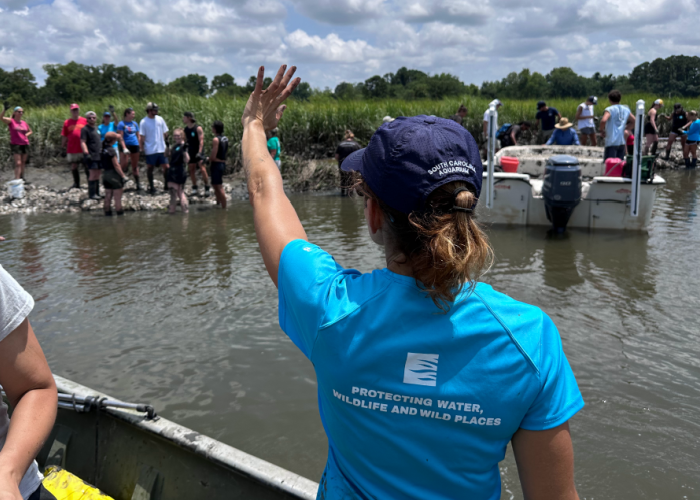Sunscreen and a positive attitude power a group of environmental champions as they don their gear and trek through the pluff mud to rebuild, restabilize and renew a beloved section of saltmarsh.
On the waterfront of the historic Maryville township, located along the Ashley River in Charleston, South Carolina, the saltmarsh and its creeks were home to a thriving ecosystem that sheltered the community from storm surge and tidal inundation and provided the community a safe place to swim, fish and relax. Since 2012, this community’s saltmarsh ecosystem has faced multiple environmental stressors, causing it to deteriorate and, unfortunately, begin to collapse.
Love and a Saltmarsh
For the past few years, the South Carolina Aquarium has worked alongside the South Carolina Department of Natural Resources (SCDNR), Georgia Institute of Technology (GA Tech) and Robinson Design Engineers implementing a long-term plan to rejuvenate the dying saltmarsh with the help of the community’s insight on the historic landscape.
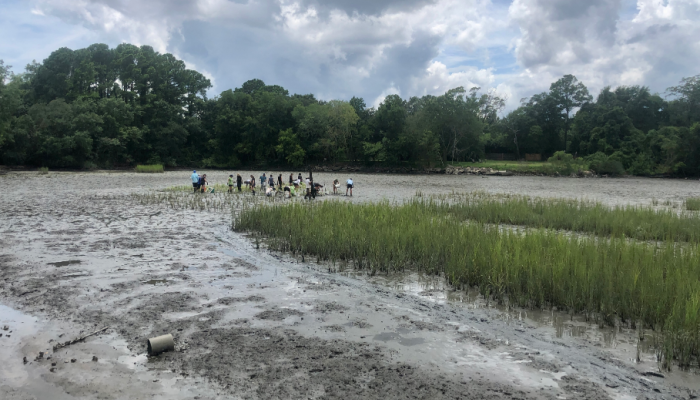 This area of saltmarsh was the community's area of concern.
This area of saltmarsh was the community's area of concern. Starting the Cycle
So, what exactly happened? After a major drought caused changes in the marsh’s waterflow, approximately 7 acres of the saltmarsh died, exposing a sizeable mudflat. With no grasses, hard substrate or water flow to this area, the saltmarsh was having trouble bouncing back on its own.
This team of experts decided to start with planting saltmarsh grass shoots on the exposed mud flat — a process similar to planting seedlings in your own garden but much messier! Each year, multiple sections of the mudflat were chosen for young saltmarsh grasses to be planted, where dozens of volunteers united to get the job done.
Four years later, we are seeing life emerge! And though the ecosystem has begun recuperating, it’s not enough to cover the entire 7 acres of mud flat.
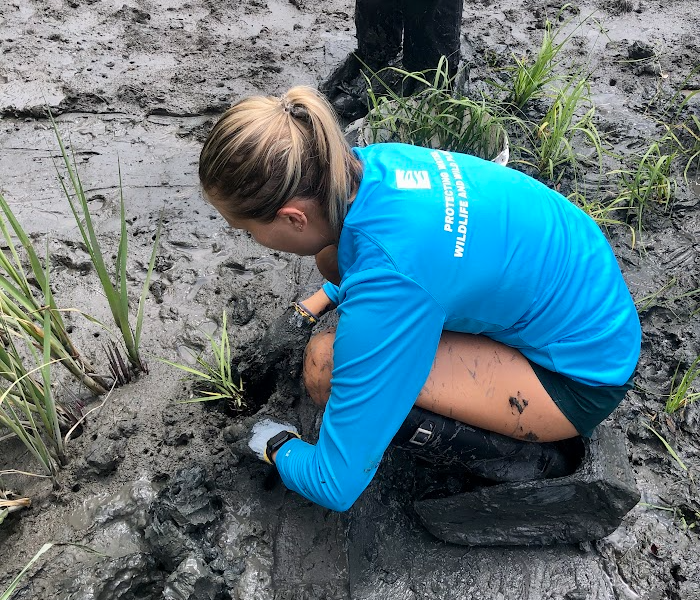 An Aquarium intern plants a saltmarsh grass sprout.
An Aquarium intern plants a saltmarsh grass sprout.Basics of Life
Water, sunlight, nutrients and a stable foundation are the basic components to a successful ecosystem. Heck, even humans need those to survive! Environmental engineers from Robinson Design Engineers and researchers from GA Tech knew the saltmarsh needed more water flow. They formulated a plan to hand-excavate a series of trenches through the mudflat over the next three years to increase waterflow to the middle of the renourishment area.
Novel Plans
Hand excavating a saltmarsh creek is… well, just as trying as it sounds! Machinery is bulky, heavy and would likely do more harm to the habitat than good. (Plus, could you imagine trying to get a tractor-sized vehicle unstuck from the pluff mud if something went wrong?)
With SCDNR leading the charge, over the course of a week this past March, staff members and volunteers from numerous environmental groups and businesses spent their days working along a section of saltmarsh measuring 134 feet, resulting in 74 cubic yards or nearly 15,000 gallons of pluff mud dug out by hand! By scooping out and dumping the mud from the inside of the trench to the outside, they created a new waterway and built a berm on either side to contain the water. The partners on this project plan to build two more creeks over the next two years and will monitor the habitat after these are complete.
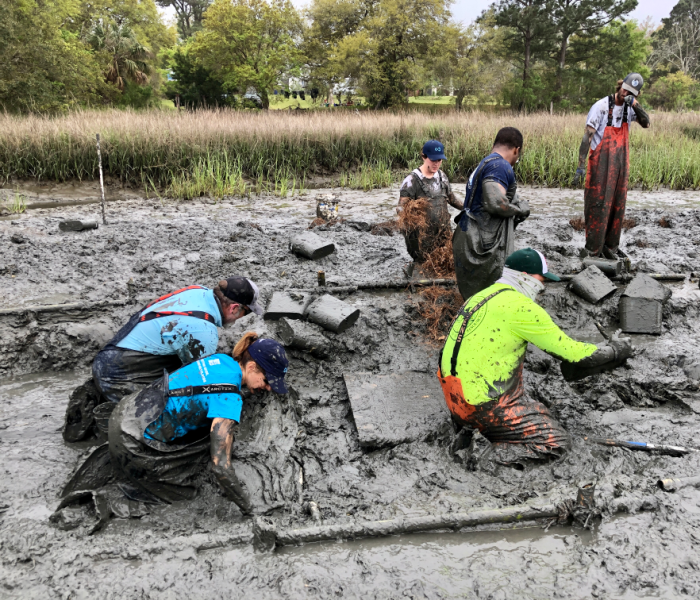 Aquarium and SCDNR staff work to remove pluff mud to build this new creek.
Aquarium and SCDNR staff work to remove pluff mud to build this new creek.Though the method of hand excavating is still very new, it may make big waves in the saltmarsh conservation field. In fact, hand excavating waterways could be utilized in remote or difficult-to-access saltmarshes across the Southeast coast that are in need of restoration.
Stable Ground
So, now that a new creek has been formed, we need something to hold it in place so it doesn’t fill in again. Enter our favorite Lowcountry seafood star: oysters! Oyster reefs are habitat forming, meaning they create homes for dozens of other species, keep water clean through filter feeding and are a natural breakwater for boat wakes, storm surge and rising tides (holding sediment in place which prevents erosion). They do all of this just by existing!
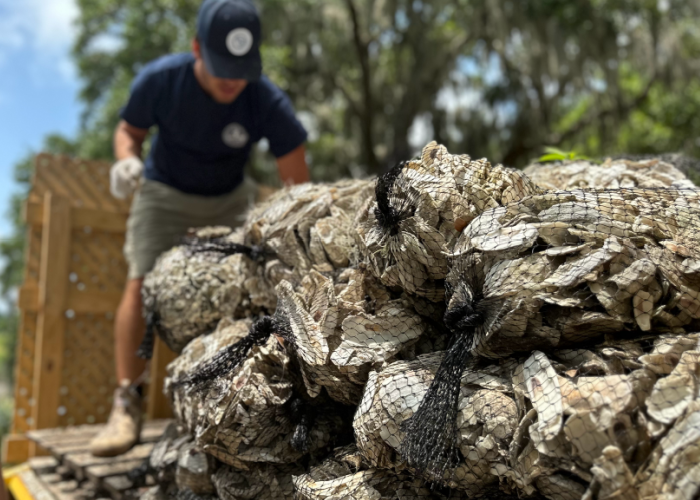 Bags of recycled oyster shells are placed along the creek banks.
Bags of recycled oyster shells are placed along the creek banks.In this newly formed saltmarsh creek, we’re helping grow a new generation of oysters by adding bags of recycled oyster shells along the bank of the newly formed creek. Oyster larvae, also known as spat, will use the recycled shells as a spot to settle and begin their new lifecycle.
Round It Out
Now we have a new creek for increased waterflow, we’ve provided stability with oyster shells and of course, nature itself offers sunlight and nutrients — the saltmarsh is on its way to serving as a robust ecosystem once again. Rounding out the recovery efforts, alongside the oyster bag installations, more young saltmarsh grasses are being planted on the berms on each side the creek, further stabilizing the sediment and creating the foundation of a lush habitat in the future.
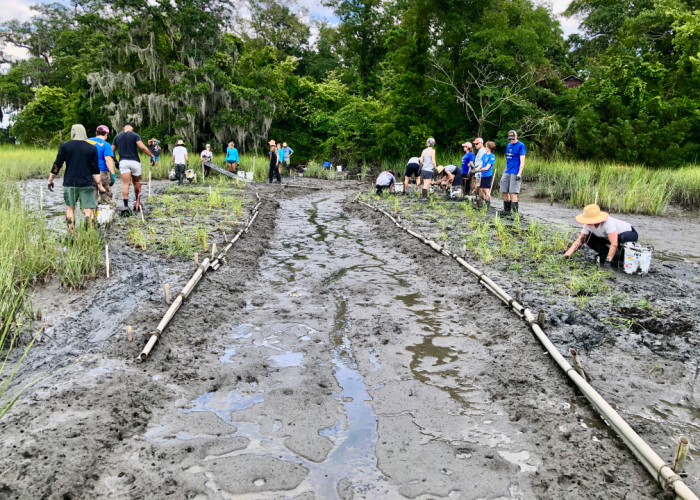 Volunteers are planting grass shoots on both sides of the creek.
Volunteers are planting grass shoots on both sides of the creek.Coming Full Circle
Revitalizing a struggling ecosystem and reconfiguring it to thrive in a shifting world is no small task. A wise conservationist once said, “Land, then, is not merely soil; it is a fountain of energy flowing through a circuit of soils, plants and animals. … When a change occurs in one part of the circuit, many other parts must adjust themselves to it.”
As the saltmarsh creeks ebb and flow, the tides rise and fall and sands shift beneath our feet, we are reminded of how fleeting some habitats can be. But with a dedicated group of experts, a passionate community and a touch of TLC, we can be an integral part of the circuit.
Join future conservation efforts like this one by becoming a volunteer Conservation Assistant!
Published July 10, 2023


